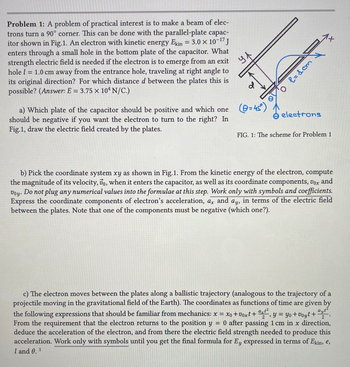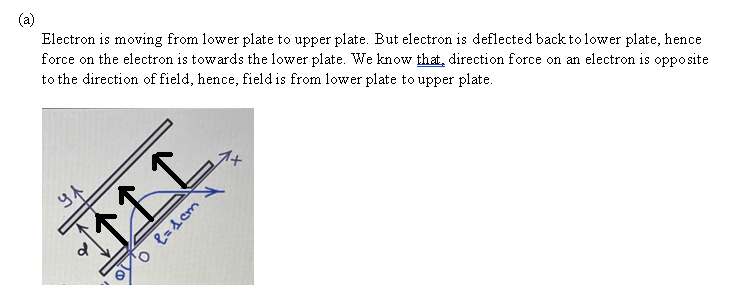Question
I need help with A,B,C,D, AND E because I don't know how to do this problem can you also label which part is A,B,C,D AND E. Thank you

Transcribed Image Text:Problem 1: A problem of practical interest is to make a beam of elec-
trons turn a 90° corner. This can be done with the parallel-plate capac-
itor shown in Fig.1. An electron with kinetic energy Ekin = 3.0 × 10-¹7 J
enters through a small hole in the bottom plate of the capacitor. What
strength electric field is needed if the electron is to emerge from an exit
hole l = 1.0 cm away from the entrance hole, traveling at right angle to
its original direction? For which distance d between the plates this is
possible? (Answer: E = 3.75 x 104 N/C.)
ул
d
a) Which plate of the capacitor should be positive and which one (@=45°)
should be negative if you want the electron to turn to the right? In
Fig.1, draw the electric field created by the plates.
1
мој =у 0,
electrons
FIG. 1: The scheme for Problem 1
b) Pick the coordinate system xy as shown in Fig.1. From the kinetic energy of the electron, compute
the magnitude of its velocity, 7o, when it enters the capacitor, as well as its coordinate components, vox and
Voy. Do not plug any numerical values into the formulae at this step. Work only with symbols and coefficients.
Express the coordinate components of electron's acceleration, ax and ay, in terms of the electric field
between the plates. Note that one of the components must be negative (which one?).
2
2
c) The electron moves between the plates along a ballistic trajectory (analogous to the trajectory of a
projectile moving in the gravitational field of the Earth). The coordinates as functions of time are given by
the following expressions that should be familiar from mechanics: x = xo +Voxt + ªxt², y = yo +Voyt +
ayt²
From the requirement that the electron returns to the position y = 0 after passing 1 cm in x direction,
deduce the acceleration of the electron, and from there the electric field strength needed to produce this
acceleration. Work only with symbols until you get the final formula for Ey expressed in terms of Ekin, e,
I and 0.¹

Transcribed Image Text:d) Now plug in the numbers into the formula for Ey to compute its value.
e) Note that there is a minimum separation dmin that the plates must have for the trajectory to fit
between them. Working with symbols only, show that if 0 = 45° the minimum separation is dmin
(there is even no need to use a calculator to compute it).
=
Expert Solution
arrow_forward
Step 1
Since we only answer up to 3 sub-parts, we’ll answer the first 3. Please resubmit the question and specify the other subparts (up to 3) you’d like answered

Step by stepSolved in 3 steps with 3 images

Knowledge Booster
Similar questions
- I need help with a University Physics 1 (Coordinate systems and Components of a vector) - The problem is described in the image below:arrow_forwardHi, I need help figuring out the answers to this. Especially how to find P and N. Also how do you get to R and the direction of Rarrow_forwardOn a Sunday a volunteer drives 1.50 km due eat of their school to deliver a booklet package in a church he then walks due north to a mall to meet a group of his friends if the magnitude of the volunteers total displacement vector at the mall with respect to the schools is 3.55 km How far north the volunteer has travelled with respect to his school ? What is the direction and angle of his total displacement vector while at the mall with respect to the school?arrow_forward
- The normalized 1s wavefunction (n = 1, l = 0) of any one-electron atom or ion can be written as 100 (r, 0, 0) = R₁0(r)Y(0,0) = Z3 παρ 3 where Z is the nuclear charge (number of protons) and a = πmpe2 €0h² (a) Construct an integral expression, in r, 0, and that can be used to determine the expectation value for the hydrogen atom potential energy, (V), and evaluate the integrals over and p. Be mindful of the integration volume element. En == e (b) Define x = Zr/ao and use this form to simplify the integral over r and evaluate it (using the tabulated integral provided above) to obtain an expression for (V). Your result should include a factor of V(a). Use the potential energy operator V(r) = where e represents the electron charge and is the permittivity of a vacuum. Express your result in terms of V(a) (that is, express it as something times V(a)). (c) The energy levels of one-electron atoms and ions can be written in terms of a as Z Z²e² (2²72²2) V (ao) = (E) 8περαon2 Using this and your…arrow_forwardNeeds Complete solution with 100 % accuracy don't use chat gpt or ai plz plz plz. I definitely upvote you for giving me correct solution.arrow_forwardū u = (4, -2) Find the direction angle of u. Enter your answer as an angle in degrees between 0° and 360° rounded to the nearest hundredth. 0 =arrow_forward
- Suppose you walk 18.0 m straight west and then 25.0 m straight north. How far are you from your starting point, and what is the compass direction of a line connecting your starting point to your final position? (If you represent the two legs of the walk as vector displacements A and B, as in Figure 21, then this problem asks you to find their sum R = A + B.arrow_forwardSolve the separable equation.arrow_forwardA has a magnitude of 23 and is located at 340° counterclockwise from the X axis determine the magnitude and angle between zero and 360 of -Aarrow_forward
arrow_back_ios
arrow_forward_ios